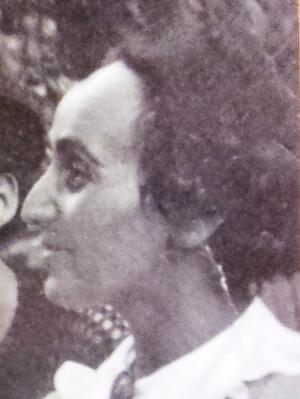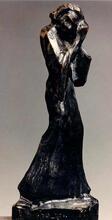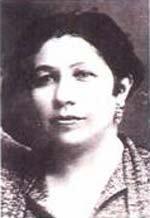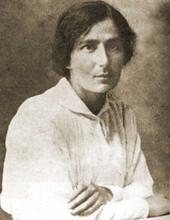Yokheved Bat-Miriam (Zhelezhniak)
Born in Belorussia to a Hasidic family, Yokheved Bat-Miriam studied pedagogy in Kharkov and at the universities of Odessa and Moscow. There, she participated in the revolutionary literary activities of a Communist literary group known as the “Hebrew Octoberists,” active between 1918 and 1926. Although Bat-Miriam eventually moved to Palestine in 1928, her emotional connection to the Russian landscape found continued expression in her poetry. Her first volume of poetry was published in 1932. Bat-Miriam’s most celebrated poem-cycle, Erez Yisrael (1937), employs the longstanding Hebrew literary convention of female personification of the Land of Israel in an iconoclastic, feminist form. Her poetry commemorates the religious and emotional lives of Jewish women and frequently focuses on women of the Bible who composed and/or recited poetry.
Overview and Early Life
“The distance that lies/between you and me/I’ll cross completely/and come before you./All of its blueness/I’ll conquer/and like a breath, swallow it,/and come/to tell you something./What shall I say?” These are the opening lines of one of Yokheved Bat-Miriam’s earliest poetry cycles, Me-Rahok (From Afar), a work that differs in form from much of her later poetry but nevertheless presages many of its themes and motifs. Originally published in Ha-Tekufah in 1922, Me-Rahok is comprised of twenty-four lyrics that proclaim the speaker’s desire to span great distances in order to unite with a lover, with God, and/or her source of poetic inspiration. The recurrent images of color, flight, distance, and a never-ending quest for spiritual transcendence are all typical of Bat-Miriam’s poetic oeuvre, while the meta-poetic questions addressed by her in poems concerning the limitations of poetic language find continued expression in such later works as Ba-Sugar (In the Cage). As a work written by one of a group of pioneering Hebrew women poets in the 1920s (including Elisheva, Rahel, and Esther Raab), the cycle also speaks to the particular experience of a Hebrew woman poet who dares to enter into the longstanding (masculine) Hebrew literary tradition—to conquer “all of its blueness”—but nevertheless wonders anxiously, “What shall I say?”
Born in a small village in Belorussia to a A member of the hasidic movement, founded in the first half of the 18th century by Israel ben Eliezer Ba'al Shem Tov.Hasidic family, Bat-Miriam studied pedagogy in Kharkov and at the universities of Odessa and Moscow. During this period, she participated in the revolutionary literary activities of a Communist literary group known as the “Hebrew Octoberists” that was active between 1918 and 1926 and that included such figures as Eliezer Steinman (1892–1970), Hiyug Abrahamson (1895–1968), Shlomo Zemah (1886–1974), Avraham Kariv (1900–1976), and Malka Schechtman (Bat-Hamah, 1898–1979). One of Bat-Miriam’s earliest poem-cycles, a paean to revolutionary Russia entitled Erez (Land), was published in the Hebrew Octoberist anthology, Bereshit (In the Beginning, 1926).
Although Bat-Miriam eventually moved to Palestine in 1928 her emotional connection to the Russian landscape found continued expression in her poetry. Emblematic of the socially rebellious tenor of her generation, Bat-Miriam never married but had two children with two different men. In 1925, while in Moscow, she had a daughter (Mariassa Bat-Miriam Katzenelson) with fellow poet and Hebrew Octoberist Shimon (Tarbukov) HaBoneh. In 1926 she moved to Paris, where in 1928 she had a son Nahum (Zuzik) with writer Hayyim Hazaz (1898–1973). Her beloved Zuzik was killed in the 1948 War of Independence, which proved to be a devastating blow. In the wake of his death Bat-Miriam ceased writing and publishing new poetry. Her first volume of poetry, which included the cycle Me-Rahok as well as seven other cycles, had appeared in 1932, four years after she settled in Palestine. In 1963 a collection of her poetry was published under the title Shirim. Bat-Miriam received the Bialik Prize in 1968 and the Israel Prize in 1972.
Analysis of Bat–Miriam’s Poetic Themes
In the critical literature about Bat-Miriam much has been said about the difference between her earlier and later poetry. Bat-Miriam’s early poems were written in a simple, vigorous idiom, without rhyme and meter. In contrast, her later poetry, influenced by the moderna movement of Abraham Shlonsky (1900–1973) and Nathan Alterman (1910–1970), was written in regularly rhymed and metered quatrains and in a dense, elliptical language. According to Ruth Kartun-Blum, the change in Bat-Miriam’s poetry after her immigration to Palestine represented a positive development in terms of the complexity and innovativeness of the figurative language. For other critics, such as Dan Miron, Bat-Miriam’s later poetry represented a stylistic and thematic regression, with her subject matter confined to conventionally feminine topics—such as love, longing and maternal feeling—and folkloric materials reminiscent of her (Yiddish) Small-town Jewish community in Eastern Europe.shtetl upbringing. Miron calls special attention to Bat-Miriam’s decision not to include in her collected poems, Shirim (1963), those early poems from Me-Rahok that demonstrated overt statements of eroticism or feminism. According to Miron, Bat-Miriam remade herself and her poetry to conform to a literary ideology that required women’s poetry to refrain from overly rebellious or iconoclastic forms and themes.
Bat-Miriam’s most celebrated poem-cycle is The Land of IsraelErez Israel (1937). Poet Nathan Alterman wrote that upon reading certain lines in Erez Yisrael all previous poetic lines about the land are momentarily silenced. The cycle is particularly relevant to this discussion insofar as it combines aspects of her earlier and later verse and therefore challenges the opposition between these two bodies of work. Erez Yisrael is also of particular interest to contemporary feminist readers because it employs the longstanding Hebrew literary convention of female personification of the Land of Israel in an iconoclastic, feminist form. Through an elaborate network of allusions to liturgical and prophetic literature as well as to the biblical book of Song of Songs, Bat-Miriam’s Erez Yisrael depicts a female poetic speaker and femininely personified land who engage in a reciprocal love-plot of pursuit and evasion. The highly elliptical, mystical language of the cycle bears the distinct influence of Russian symbolist poetry. At the same time, the continually shifting and blurring identities of both the feminized land and the female poetic speaker seem to anticipate the efforts of contemporary French feminist critics such as Hélène Cixous and Luce Irigaray (b. 1930) to posit an alternative woman’s writing that challenges conventional gender oppositions and fixed linguistic meanings.
The poetic recovery of women’s voices and spiritual practices figures prominently in Bat-Miriam’s poetry. In such early cycles as Vilon (Curtain) and Hamah yeshanah (Old Sun), both included in Me-Rahok, Bat-Miriam poetically commemorates the religious and emotional lives of Jewish women, including the creation of ritual objects and the recitation/composition of Yiddish prayers or Tkhines. Bat-Miriam’s poetry also evinces an interest in those women of the Bible who composed and/or recited poetry. According to her daughter, Dr. Mariassa Bat-Miriam Katsenelson, Yokheved Bat-Miriam intentionally changed her last name from a patronym (Zhelezniak) to a matronym, Bat-Miriam, “because she saw herself as the daughter of that same Miriam, the sister of Moses, the first woman poet in Israel.” Bat-Miriam’s first book of poetry bears the imprint of the Miriam story. The title Me-Rahok and the numerous repetitions of this word throughout the book all allude to the biblical account of Miriam standing “from afar” as baby Moses was set adrift in a basket upon the Nile (Exodus 2:4). The connection between Bat-Miriam and her biblical ancestor are further represented in the two later poems in which she poetically resurrects the biblical prophet/poet, identifying her as a personal source of poetic inspiration. The first poem, “Kifsukim Ha-Yamim” (Like Verses the Days, 1929) depicts the poet-speaker inhabiting a biblical landscape and dancing together with the biblical Miriam, thereby uncovering Miriam’s “ancient Sea-Song concealed in parchment.” The second poem, “Miriam,” offers a more comprehensive portrait of the biblical Miriam and develops the theme of identification between the contemporary poet and her biblical foremother. Bat-Miriam’s other poetic treatments of biblical women—Eve, Hagar, Hannah—are all marked by an awareness of the unprecedented and therefore subversive nature of female Hebrew literary interaction with the biblical text.
In terms of critical reception of her work, Ruth Kartun-Blum’s Ba-Merhak Ha-Ne’elam (Receding Horizons, 1977) remains the only book-length study of Bat-Miriam’s poetry. Various reasons have been adduced for this scarcity of critical interest, primarily the highly complex, hermetic quality of Bat-Miriam’s work. More recently, however, with the publication of Dan Miron’s pathbreaking study Imahot Meyasdot, Ahayot Horgot (Founding Mothers, Stepsisters, 1991) and under the influence of feminist theory and gender studies, there has been revived interest in Bat-Miriam’s rich and multivalent poetry.
Selected Works by Yokheved Bat-Miriam (Zhelezhniak)
Erez (Land).
In Bereshit (In the Beginning). Berlin: 1926.
Me-Rahok (From Afar). Tel Aviv: 1932. Reprinted in 1985.
Re’ayon (Interview). Tel Aviv: 1940.
Demuyyot me-Ofek (Images from the Horizon). Tel Aviv: 1941.
Erez Yisrael (The Land of Israel). Tel Aviv: 1942.
Mi-Shirei Rusyah (Poems of Russia). Tel Aviv: 1942.
Shirim la-Ghetto (Poems to the Ghetto). Tel Aviv: 1943.
Shirim (Poems). Tel Aviv: 1963. Reprinted in 1972.
Alterman, Nathan. “A few words at this great moment for our poetry” (Hebrew). In the Circle: Articles and Notes. Tel Aviv: 1971.
Gilboa, Yehoshua. Hebrew Octoberists: History of an Illusion (Hebrew). Tel Aviv: 1974.
Goell, Yohai. Bibliography of Modern Hebrew Literature in English Translation. Jerusalem and New York: 1968.
Jacobson, David. “Religious Experience in the Early Poetry of Yokheved Bat-Miriam,” Hebrew Annual Review 5 (1981): 47–64.
Kartun-Blum, Ruth. Receding Horizons: Studies in the Poetry of Y. Bat-Miriam (Hebrew). Ramat Gan: 1977.
Kartun-Blum, Ruth. “My Mother, Yokheved Bat-Miriam” (Hebrew). Sadan 2 (1996): 153–163.
Pardes, Ilana. “The Poetic Strength of a Matronym.” In Gender and Text in Modern Hebrew and Yiddish Literature, edited by Naomi B. Sokoloff, Anne Lapidus Lerner and Anita Norich. New York: 1992.
Zierler, Wendy. “Chariot(ess) of Fire: Yokheved Bat-Miriam’s Female Personifications of Erets Israel.” Prooftexts 20:1–2 (Winter/Spring 2000).
Idem. And Rachel Stole the Idols: The Emergence of Modern Hebrew Women’s Writing. Detroit: 2004, Chapters 1, 2, and 3.






